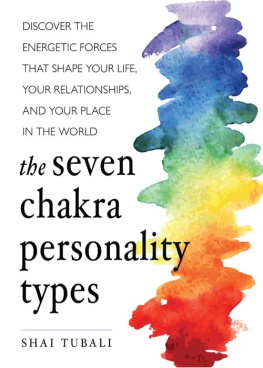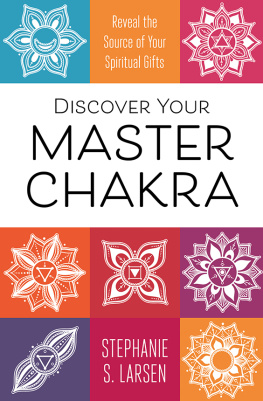
Praise for The Seven Chakra Personality Types
Life guidance as to why we are who we are. Shai has made a great contribution to the vibrant living library of evolving human consciousness in a most integrated, readable, and admirable way. His insights encourage the reader to understand the deep connections between chakras, mind, body, and spirit. A must read.
Patricia Mercier, author of bestselling The Chakra Bible and The Little Book of Chakras
A magnificent way to understand yourself as a spiritual being having a physical experience. Highly recommended!
C. Norman Shealy, MD, PhD, author of Living Bliss: Major Discoveries Along the Holistic Path
In an era in which we frequently limit our perspective of ourselves to a body, mind, or soul, this book is a wonderful invitation to experience yourself as an inspiring integration of all three.
Dr. Itai Ivtzan, associate professor, Naropa University, and mindfulness teacher and researcher
A new perspective of the chakras representing archetypal personalities. This integrative approach identifies and illuminates spiritual, mental, and emotional patterns that give clarity toward soul essence and personal path.
Francesca McCartney, PhD, Academy of Intuition Medicine
A peaceful world starts with a peaceful mind, and this book encourages peace by helping us understand all facets of our being, helping us to embrace other points of view, and leading us to experience wholeness within ourselves.
Cindy Lora-Renard, spiritual life coach and author of A Course in Health and Well-Being

This edition first published in 2018 by Conari Press, an imprint of
Red Wheel/Weiser, LLC
With offices at:
65 Parker Street, Suite 7
Newburyport, MA 01950
www.redwheelweiser.com
Copyright 2018 by Shai Tubali
All rights reserved. No part of this publication may be reproduced or transmitted in any form or by any means, electronic or mechanical, including photocopying, recording, or by any information storage and retrieval system, without permission in writing from Red Wheel/Weiser, LLC. Reviewers may quote brief passages.
ISBN: 978-1-57324-736-8
Library of Congress Cataloging-in-Publication Data available upon request.
Cover design by Kathryn Sky-Peck
Interior by Steve Amarillo / Urban Design LLC
Typeset in Adobe Garamond, Gill Sans and Myriad Pro
Printed in Canada
MAR
10 9 8 7 6 5 4 3 2 1
www.redwheelweiser.com/newsletter
Dedicated to my soul family:
Tamar, Noga, Alaya, Philipp, Mimi, Theresa, Jan, and Nir.
All of you are rays of the great sun, beautiful
embodiments of your own chakra types.
CONTENTS
ACKNOWLEDGMENTS
My heartfelt gratitude to Noga and Jan Mller, the managers of my Berlin center, who supported the writing process from beginning to end. They toiled tirelessly to build up the one-year school platform from which this book emerged.
I am profoundly thankful to Florian Stndel, who meticulously transcribed all the hundreds of hours of the school teachings, enabling me to refine them into the essential content of this book.
My deep gratitude also to my designer, Oliver Bruehl, for creating the two effective visual models found in these pages.
Finally, I humbly acknowledge the many participants of the 2017 Seven Chakra Types school. Your enthusiasm, intense questioning, and curiosity helped to deliver numerous insights that have greatly clarified this system.
PREFACE
The seven chakras (Sanskrit for wheels or circles) belong to a Hindu system originating in India between 1500 and 500 BC, which makes it one of the oldest and most persistent systems the world has ever known. They were introduced by the seers of ancient India as seven major confluences within our subtle nerve network that also function as psychic centers of energy and consciousness. Each chakra relates to a set of energetic, emotional, mental, and spiritual activities. Thus each is a powerful determinant of all levels of human existence.
The chakras are often reduced to a simplistic set of seven energy centers known in the popular literature for their symbols and colors. This literature focuses, for the most part, on general principles of healing, balancing, and awakening. It generally presents only a superficial understanding of the chakras as centers of emotional energy and spiritual power.
At a deeper level, however, the chakras define seven centers of perception and experience. Through these centers, we each encounter and experience our own multidimensional reality. When you look at life through the lens provided by the chakras, you discover that life can be seen in specific and distinct ways, and in light of this discovery, different values, meanings, and happiness become far more relevant.
The chakra personality types derive from the seven different worldviews related to the seven individual chakras. Your own personality type depends on which center of perceptionwhich chakrais aroused most easily in you and most naturally gets in touch with reality before all others do. This intense identification with your chakra's perspective forms your most fundamental personality typewhat I call your major chakra type.
Within this broader context, the chakras show us how our so-called individual inclinations can be classified into seven types of perception and experience. Unfortunately, we are rarely introduced to the chakras as illuminators of our individual paths and as indicators of the way our individual journeys unfold or could unfold.
We all possess seven chakra energies that make up our human wholeness, although some are far more active and some are relatively negligiblenot necessarily because we have neglected certain aspects of our being, but rather because we are inherently destined to embody and bring to full flowering one major aspect of life and the cosmos.
The system of personality types presented here is a development of fundamental principles found in yogic teachings. Throughout my years of theoretical and experiential research in the field of chakras, I began to notice suggestions of personality types that sprang from the individual chakras and that corresponded with unique perspectives. These suggestionsoften brief and superficialseemed to represent human archetypes that included animal symbolisman ant representing the first chakra, a butterfly representing the second, and so on.
As I dug deeper into these correspondences, I came to realize that our individual differences and unique expressions all fall into seven major categories related to the seven chakras. Indeed, each category defined a world unto itself comprised of tendencies, attractions, and passions. A closer examination of this principle convinced me that each of us identifies with one major chakra and, to a lesser degree, with one or two other chakras.
This insight enabled me to appreciate the hidden elements behind all personalitiesa sort of soul designbased on profound inclinations that, when fulfilled, make each of us feel happier and more complete than in any other possible condition in life. This is the system I present to you here.
CHAKRA PERSONALITY TYPE IN WORLD POPULATION

Next page











